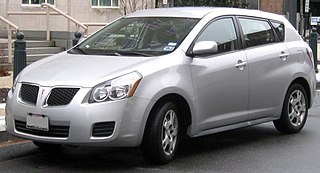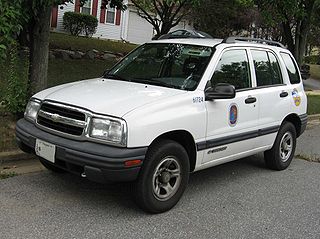
Pontiac, or formally the Pontiac Motor Division of General Motors, was an American automobile brand owned, manufactured, and commercialized by General Motors. It was originally introduced as a companion make for GM's more expensive line of Oakland automobiles. Pontiac quickly overtook Oakland in popularity and supplanted its parent entirely by 1933, in turn establishing its position as one of GM's dominant divisions.

The Pontiac Vibe is a compact car that was sold by Pontiac from 2002 to 2010. It was jointly developed by General Motors along with Toyota, which manufactured the mechanically similar Toyota Matrix. Manufactured by the Toyota-GM joint venture NUMMI in Fremont, California, the Vibe succeeded the Chevrolet Prizm in production at NUMMI and like the Prizm, it was derived from the Toyota Corolla, making it the last of the GM and Toyota developed S-body cars.

The Saturn Corporation, also known as Saturn LLC, was an American automobile manufacturer, a registered trademark established on January 7, 1985, as a subsidiary of General Motors. The company was an attempt by GM to compete directly with Japanese imports and transplants, initially in the US compact car market. The company was known for its 'no-haggle' sales technique.

The Pontiac Sunbird is a model line that was manufactured and marketed by Pontiac from the 1976 to the 1994 model years. Loosely deriving its name from the Pontiac Firebird, the Sunbird was introduced as the eventual replacement for the Pontiac Astre, replacing it entirely in 1978 as the smallest Pontiac.
Geo was a brand of small cars marketed by General Motors (GM) as a subdivision of its Chevrolet division from 1989 to 1997.

In the automotive industry, rebadging is a form of market segmentation used by automobile manufacturers around the world. To allow for product differentiation without designing or engineering a new model or brand, a manufacturer creates a distinct automobile by applying a new "badge" or trademark to an existing product line.

Captive import is a marketing term and a strategy for a vehicle that is foreign-built and sold under the name of an importer or by a domestic automaker through its own dealer distribution system.

The Pontiac LeMans is a model name applied to automobiles marketed by Pontiac. The name came from the French city of Le Mans, the site of the 24 Hours of Le Mans, the world's oldest active sports car endurance race that began in 1923. Originally a trim upgrade package based on the Tempest, the LeMans became a separate model in 1963.

The Chevrolet Tracker, formerly the Geo Tracker, is a mini SUV produced for Chevrolet and Geo by CAMI Automotive in Ingersoll, Ontario. The Tracker was produced under many brands in several different editions and in many countries.

The Geo Storm is a sport compact car manufactured by Isuzu that was sold in the United States by Geo from 1990 until 1993. The same vehicles, with minor variations, were sold by Geo in Canada in the 1992 and 1993 model years only. The Storm was intended to be a budget car with the look and feel of a sports car. It was sold in two-door liftback and hatchback forms.

The Isuzu Piazza is a small, sporty 3-door liftback coupé which was manufactured by Isuzu from 1981 until 1992 in two generations. The Isuzu Piazza was marketed as the Isuzu Impulse in North America and as the Holden Piazza in Australia.

The Isuzu Gemini is a subcompact car produced by the Japanese automaker Isuzu from 1974 until 2000. The same basic product was built and/or sold under several other names, sometimes by other General Motors brands, in various markets around the world. While the first generation was of a rear-wheel drive design, later versions were all front-wheel-drive, and the last two generations were no more than badge-engineered Honda Domani until the name was retired in 2000.

The Suzuki Cultus is a supermini car produced by the Japanese manufacturer Suzuki from 1983 to 2016. The nameplate is currently used as a rebadged second-generation Suzuki Celerio in Pakistan since 2017. It was first presented at the 25th Tokyo Motor Show, formally introduced to Japan in 1983 and ultimately sold in seven countries and marketed worldwide as the Suzuki Swift. An alliance formed in 1981 between General Motors, Suzuki and Isuzu allowed GM to market the Cultus as a captive import internationally under more than a dozen nameplates including the Geo Metro, Chevrolet Sprint, Pontiac Firefly, Isuzu Geminett and Holden Barina. It was also known as the M-car within GM.
General Motors New Zealand Limited, formerly Holden New Zealand Limited, is a subsidiary of General Motors that distributes GM' motor vehicles, engines, components and parts in New Zealand.

GMT 360 is a vehicle platform that was manufactured by General Motors from the 2002 and 2009 model years. Designed primarily for SUVs, the GMT360 architecture served as the third generation of mid-size SUVs produced by GM. Directly succeeding its GMT330 predecessor in the United States, GMT360 vehicles based on the platform were sold with their predecessor in Canada and export markets through 2005.

Passport International Automobiles (PIA) was a Canadian car dealership network owned by General Motors. It sold vehicles from Isuzu and Saab as well as its own branded Passport Optima, a Korean (Daewoo) made badge engineered Opel Kadett E, starting in model year 1988. General Motors' Geo import brand was introduced in the United States at about the same time. Sales began in mid-1987, originally only in major metropolitan areas. Only 83 I-Marks and Optimas were sold in 1987.

General Motors reused the T-body designation, beginning in 1979 with the front-wheel drive Opel Kadett D and the Vauxhall Astra Mk I. This was part of a global strategy by GM to introduce a new front-wheel drive architecture for its sub-compact models, and would be further developed into the J-body platform which would cover the compact size segment.


















